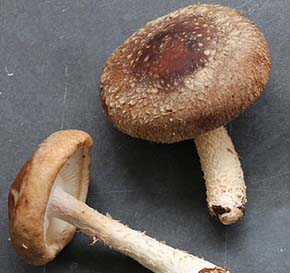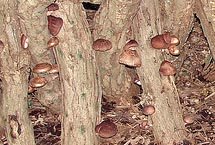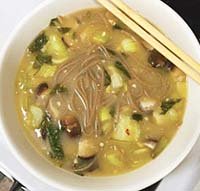Shiitake (椎茸) mushroom Nutrition facts
Flavorful, earthy, shiitake mushrooms are the next commonly cultivated types after button mushrooms. Originally, Shiitake were the fruiting bodies found on dead wood logs of "Shii tree" (Castanopsis cuspidata) from where they get their name. Botanically, they belong to the family: Marasmiaceae, and the genus: Lentinula.
They are also known by the names Hua Gu, oak mushroom, black forest mushroom, Oriental black mushroom, golden oak mushroom, etc.
Family: Omphalotaceae, Genus: Lentinula.
Scientific name: Lentinula edodes.
 |
| Shiitake mushrooms Photo courtesy: Simon Huntley. |
Identification
These edible fragrant mushrooms are most commonly used in East-Asian cuisine. Shiitake features a strong earthy flavor and chewy texture. They feature larger, fleshy caps with tough (woody) stalks.
The cap is rounded convex, light brown in color, with undersurface gills appearing cream-white, measuring about 2-6 inches in diameter.
The stem is 3-5 inches in length. The stems are woodier than the stems of most other mushrooms. Its white flesh is slightly acidic in flavor and but pleasant tasting and has a meaty, distinct slippery texture.
Cultivation
 |
| Cultivation of shiitke on wooden logs. Photo courtesy: dominlk18s |
In their natural habitat, shiitake mushrooms grow on old logs and dead tree trunks, and because of this, they are sometimes labeled as hardwood mushrooms.
In the cultivated farms, the crop tended on custom-sized logs and sawdust. Spawn inoculated logs kept under shade for up to 8-12 months. Once the mycelia spread all along the length of the logs, they are forced by submerging in cold water in order to time the crop for bulk harvesting. Each well-maintained 4 feet length log could yield up to 2-4 pounds of shiitake at a time.
7 Amazing Health Benefits of Shiitake mushrooms
Shiitake, fresh or dried, is one of the low-calorie foods. 100 grams carry about 34 calories.
Shiitake compose of chemical constituents such as eritadenin and polysaccharide lentinan. Eritadenine, a purine alkaloid, was found to lower serum cholesterol levels in animal studies. Lentinan acts as an immune modulator and is known to inhibit tumor growth.
Shiitake indeed carries modest levels of vitamin D in the form of ergocalciferol (vit.D-2). 100 grams contain about 18 IU of vitamin D. It is an essential fat-soluble vitamin required for bone growth and calcium metabolism.
The mushroom contain more niacin, pantothenic acid, pyridoxine than button mushrooms. 100 g contains 0.293 mg of vitamin B-6 (pyridoxine). Pyridoxine improves GABA neurotransmitter levels in the brain.
100 g of shiitake mushrooms carry 112 mg or 16% RDI of Phosphorus. Adequate calcium and phosphorus levels in the blood are critical for the proper mineralization of bone and teeth.
Selenium is co-factor nutrient for the antoxidant enzyme, glutathione peroxidase. It plays a vital role in the integrity of liver and heart tissues.
Furtner, it is also a modest source of other important minerals like copper, zinc, and iron.
| Principle | Nutrient Value | Percent of RDA |
|---|---|---|
| Energy | 34 Kcal | 2% |
| Carbohydrates | 3.26 g | 2.5% |
| Protein | 2.24 g | 4% |
| Total Fat | 0.49 g | 2.5% |
| Dietary Fiber | 2.5 g | 7% |
| Vitamins | ||
| Folates | 13 μg | 3% |
| Niacin | 3.877 mg | 24% |
| Pantothenic acid | 1.500 mg | 27% |
| Pyridoxine (B-6) | 0.293 mg | 23% |
| Riboflavin | 0.217 mg | 17% |
| Thiamin | 0.015 mg | 1% |
| Vitamin D | 18 IU mg | 3% |
| Electrolytes | ||
| Sodium | 9 mg | 0.5% |
| Potassium | 304 mg | 7% |
| Minerals | ||
| Calcium | 2 mg | <1% |
| Copper | 0.142 mg | 16% |
| Iron | 0.41 mg | 5% |
| Magnesium | 20 mg | 5% |
| Manganese | 0.230 mg | 1% |
| Phosphorus | 112 mg | 16% |
| Selenium | 5.7 μg | 10% |
| Zinc | 1.03 mg | 9% |
Selection and storage
Fresh as well as dried shiitake can be readily available in supermarkets around the year. Shiitake can be easily identified by its large, brown caps with thick woody stems.
Choose uniform, well-formed, firm mushrooms featuring small stems. Avoid large, opened-up caps and tough stem mushrooms as they pass their prime.
Once at home, use them early. Shiitake mushrooms are a little less fragile than other mushrooms. To store, place them inside a paper bag and keep them in the refrigerator where they stay fresh for up to 7- 10 days. Store dried shiitakes in a cold, dry, and dehumidified place.
Preparation and serving methods
Clean, fresh shiitake mushrooms with a cloth or damp paper towel. In general, you don't need them to wash in water. If at all give them a wash, and hold them briefly under running water. Do not let them soak and dry immediately. Trim the tough, fibrous stalks using a paring knife. Do not discard but use these stems to make stock.
Dried shiitakes should be soaked in water and revitalized before adding to cooking. Soak them in either hot or cold water until rehydrated. Do not discard the soaking liquid as is very flavorful and use it to prepare stock, or add in soups, sauces, stews, and stir-fries.
The smoky, earthy flavor and meaty, chewy texture of shiitake make them one of the most sought-after kinds of mushrooms worldwide. They can be used in the same way as any other mushroom. They absorb the flavor of the dishes.
 |
| Shiitake mushrooms in miso soup. Heidi De Vries |
Here are some serving tips:
Fresh shiitake are delicious sauteed, stir-fried, marinated and grilled, or braised.
Shiitake is delicious in soups, sauces, pasta dishes, rice (caramelized shiitake risotto), stews, and stir-fried dishes.
Broad shiitake can be employed in the stuffing.
Fine sliced, diced shiitake is a common featuring ingredients in pizza, pasta, pastry, and potpie preparations.
They also complement well with seafood, lamb, and poultry in a variety of mouth-watering recipes.
Safety profile
Allergic reactions to the consumption of shiitake mushrooms are not common. Some sensitized persons who actively take part in the cultivation may develop allergic contact dermatitis to shiitake.(Medical disclaimer).
You may also like to read:-
Bolete mushroom nutrition facts and health benefits.
Button mushrooms nutrition facts and health benefits.
Morel mushrooms nutrition facts and health benefits.
Truffles nutrition facts and health benefits.
≺≺ Back to Mushrooms from Shiitake mushroom nutrition. Visit here for an impressive list of edile mushrooms with complete illustrations of their nutrition facts and health benefits.
≺≺ Back to Home page.
Further reading and Resources:
Stanford School of Medicine Cancer information Page- Nutrition to Reduce Cancer Risk. (Link opens in new window).